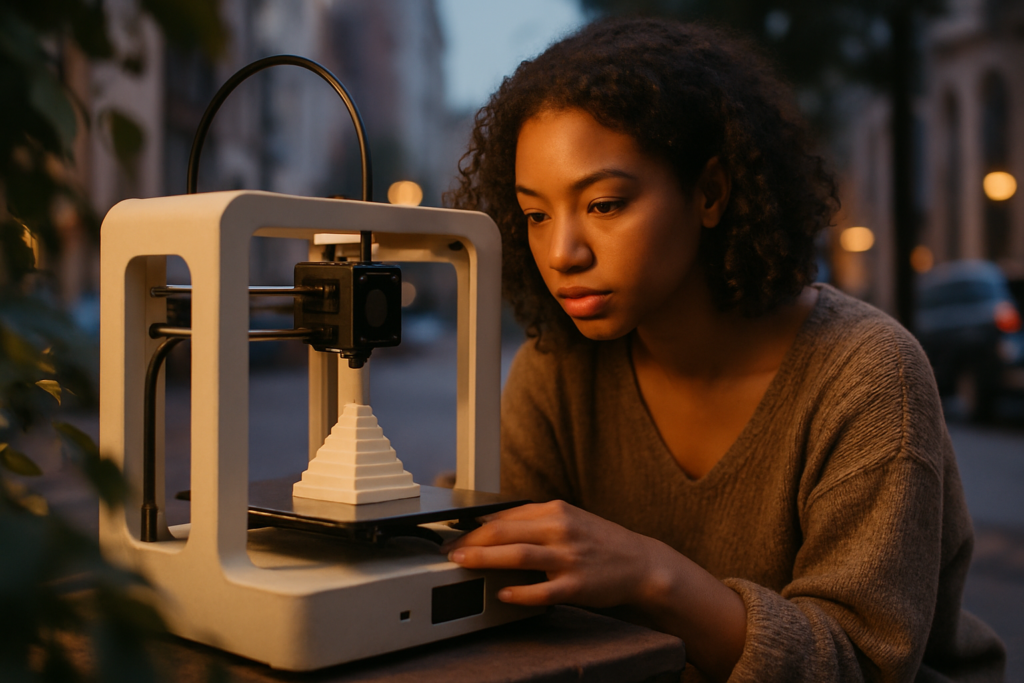Shifting Tools, Shifting Possibilities
For centuries, sculpture relied on hand tools, physical endurance, and slow, deliberate work. Stone had to be chiseled. Clay had to be molded by hand. That kind of labor intensive process shaped not just the outcome, but the entire mindset of sculptural practice. Now? That’s changing.
Digital fabrication especially 3D printing is reshaping what sculpture can be. Artists are no longer bound by the limits of manual processes. Scanning, modeling, and printing allow creators to design complex internal cavities, precise joints, and delicate structures that hands alone couldn’t make or repeat without enormous effort. The shift isn’t erasing the hand; it’s integrating it with machines.
Many artists are choosing hybrid workflows: starting with sketches or clay models, digitizing them, and using software to scale, refine, or iterate. Machines handle the tedious parts mass production, precision cuts, repetitive components while the artist fine tunes form, texture, and assembly.
This mash up of handcraft and tech doesn’t just change what’s possible it changes the pace and purpose too. Speed increases. Complexity rises. And repeatability means sculptors can experiment more freely, knowing they can revise and reprint. The end result? A new sculptural language that’s part analog, part algorithm and entirely 21st century.
Material Flexibility and Structural Freedom
The material menu has expanded. Artists are no longer confined to clay, bronze, marble. Now it’s PETG, PLA, resin infused composites, and hybrid metals all available with the click of a slicer. These aren’t just new materials; they’re new languages. They’re letting artists scale up without the old weight problem. Monumental sculptures can now be light enough to suspend mid air. What used to require scaffolding and team lifts can be carried, unstacked, and reassembled like puzzle pieces.
3D printing also liberates form. Internal supports can be printed directly into a structure hollow, latticed, or ribbed making shapes that once seemed impossible suddenly routine. Think: twisted towers with voided cores, mesh masks the size of windshields, or floating biomorphic blobs that seem to ignore gravity. Objects once imagined in sketchbooks but abandoned for being “unbuildable” now come alive with layer by layer precision.
It’s not just about inventing new looks it’s about the freedom to build without compromise.
From Studio to Screen: Digital Workflows
As technology becomes an integral part of contemporary sculpture, the gap between traditional studio practices and digital tools continues to narrow. Sculptors are embracing a range of digital workflows that expand creative boundaries while complementing hands on methods.
Scanning and Modeling with CAD Software
Digital modeling is now a foundational skill for many sculptors. Artists use CAD (Computer Aided Design) programs to:
Transform concept sketches into three dimensional forms
Refine scale, proportion, and detail with surgical precision
Simulate materials and structural integrity before fabrication
High resolution 3D scanning also allows artists to digitize physical objects whether organic forms, clay maquettes, or existing works for further manipulation or replication.
Bridging Physical Techniques and Tech Fluency
Artists trained in traditional techniques are rapidly adopting digital fluency, integrating software tools into their iterative design processes. Instead of replacing handwork, digital tools:
Serve as a preparatory or experimental stage
Enable rapid prototyping, helping sculptors visualize multiple versions
Offer a new layer of control while preserving creative intuition
This hybrid workflow empowers artists to merge craftsmanship with the precision of machine guided design.
Collaboration Between Artists and Technologists
The line between artist and engineer is increasingly fluid. Sculptors are working alongside digital specialists including 3D modelers, software developers, and fabrication technicians to bring ambitious projects to life.
Some key collaboration outcomes include:
Sculptural installations using generative design algorithms
Large scale public works incorporating structural simulations
Experimental materials engineered through joint research
These partnerships not only support technical execution but also open up new possibilities in theme, form, and function.
By embracing digital workflows, contemporary sculptors are simultaneously preserving their tactile roots and propelling their practice into a future shaped by precision, adaptability, and innovation.
Conceptual Expansion Through 3D Tech

Sculpture isn’t sitting still anymore literally. More artists are using 3D printing not just to create objects, but to build systems. Think modular pieces that change depending on how they’re arranged, or kinetic elements that respond to touch, sound, or motion. These works don’t just ask to be looked at they want to be activated, handled, sometimes even hacked.
It’s a shift from permanence to process. A printed sculpture can be duplicated, tweaked, or rebuilt with slight variations. That opens the door to deeper commentary on identity: What’s the original? What version is most authentic? Questions like these surface when an object isn’t fixed but fluid, made to evolve.
For artists exploring modular design or identity through duplication, the connection with technologies like projection mapping becomes clear. Both blur boundaries between static and dynamic, form and experience. (Explore more on that front here: projection mapping evolution)
In the end, 3D tech isn’t just changing how sculpture looks it’s changing what sculpture is allowed to be.
Accessibility, Democratization, and New Voices
3D printing has carved out space for more voices especially those who’ve been sidelined in the traditional art ecosystem. The high cost of materials, studio access, and fabrication tools used to be walls. Now, they look more like speed bumps. Thanks to the rise of community makerspaces and open source design files, emerging and underrepresented artists can prototype, iterate, and produce ambitious work without draining their bank accounts.
This shift isn’t just about tools it’s about opportunity. Artists can experiment outside of rigid academic or gallery structures. A student sculptor with $100 and a weekend at a makerspace can now produce something that used to require institutional support. Shared tech and shared knowledge levels the field.
Even the sculpture world’s gatekeepers are adapting. Competitions and gallery shows are starting to recognize digitally printed works, sometimes even favoring artists who push the medium into new conceptual territory. The format is evolving, and so are the expectations what “counts” as sculpture is being rewritten in real time, one extruded layer at a time.
Where Innovation Meets Aesthetics
The Debate: Speed vs. Soul
The rapid production capabilities of 3D printing have ignited a debate within the art world: does faster fabrication diminish the emotional and aesthetic depth of sculpture? While machine made components offer precision and efficiency, some argue that they can risk feeling impersonal or overly mechanical.
Key considerations:
Traditionalists stress the importance of imperfections as a marker of human presence.
Digital fabrication can feel sterile if not paired with thoughtful design.
Some artists use the tension between speed and soul as a core conceptual theme.
Redefining the ‘Artist’s Touch’
In the digital age, the artist’s presence is not confined to hand sculpting material it extends to code, design files, and digital manipulation. The “touch” now resides in both physical gestures and virtual decisions.
New interpretations of authorship include:
Curating and designing print ready 3D forms
Guiding machine behavior and toolpaths as creative acts
Combining physical modification post print to add signature flourishes
Sculptural Form and Viewer Expectations
Contemporary audiences are rethinking what sculpture can and should be. With 3D printing, forms that once seemed implausible due to material or structural limits are now common.
This shift challenges:
Expectations of weight, texture, and scale sourced from traditional materials
The role of negative space and hollow forms
Our understanding of permanence in sculptural practice
As technology informs aesthetics, many artists are not abandoning tradition, but transforming it merging legacies of form with the limitless possibilities of digital creation.
Looking Forward
As 3D printing matures within contemporary sculpture, it’s not just the form or the process that’s evolving it’s the entire conceptual framework of what sculpture can be. The next phase of innovation is pushing beyond fabrication into sustainability, interactivity, and biological integration.
Sustainable Practices with Recyclable Materials
Environmental awareness is increasingly influencing how artists choose and handle their materials. 3D printing aligns with this shift:
Recyclable or biodegradable filaments are replacing petroleum based plastics in many studios.
Closed loop systems allow for reusing waste material or failed prints.
Artists are experimenting with natural composites, such as wood fill polymers or algae based resins, blending ecological mindfulness with creative exploration.
These steps signify a broader movement toward sustainable practices in sculpture without compromising visual or conceptual impact.
Integrating AR, Robotics, and Biofabrication
Sculpture is transitioning from static form to dynamic experience. Through integration with other technologies, sculptors are redefining how an audience interacts with artwork:
AR (Augmented Reality) overlays can animate or contextualize physical sculptures, layering narrative elements or extended visuals.
Robotics introduces motion, reinvigorating kinetic sculpture with responsive behaviors based on environmental inputs.
Biofabrication printing with living cells or organic matter is introducing provocative questions around life, growth, and decay as sculptural material.
These approaches signal the breakdown of disciplinary boundaries, placing sculpture at the intersection of biology, engineering, and immersive technology.
Beyond the Tool: 3D Printing as Medium
As artists continue to stretch the capacities of 3D printing, it’s increasingly viewed not merely as a convenient tool but as a stand alone medium. This reframe opens up new layers of intentionality:
Forms are designed specifically to showcase layering artifacts, turning mechanical precision into visible aesthetic choices.
Failure and glitch aesthetics once technical flaws are now embraced as stylistic innovations.
Artists engage directly with algorithmic generativity, coding form into existence rather than sculpting it by hand.
3D printing, in this light, joins clay, bronze, and marble as a material with its own language and expressive possibilities.
(For more on tech art intersections, revisit projection mapping evolution.)

 Anna Freehill, a key contributor to Avant Garde Artistry Hub, plays a vital role in shaping the platform’s vision. As an author and collaborator, she helps bridge the worlds of art and technology, offering insightful articles that guide artists through the rapidly evolving creative landscape. Anna’s dedication to highlighting art's therapeutic value has contributed to the platform’s focus on mental and emotional well-being through creative expression.
Her involvement in building Avant Garde Artistry Hub has been instrumental in providing valuable resources to artists seeking to enhance their careers. Whether through her writing on business strategies or her support in platform development, Anna is committed to fostering a space where artists can thrive and embrace the future of art.
Anna Freehill, a key contributor to Avant Garde Artistry Hub, plays a vital role in shaping the platform’s vision. As an author and collaborator, she helps bridge the worlds of art and technology, offering insightful articles that guide artists through the rapidly evolving creative landscape. Anna’s dedication to highlighting art's therapeutic value has contributed to the platform’s focus on mental and emotional well-being through creative expression.
Her involvement in building Avant Garde Artistry Hub has been instrumental in providing valuable resources to artists seeking to enhance their careers. Whether through her writing on business strategies or her support in platform development, Anna is committed to fostering a space where artists can thrive and embrace the future of art.